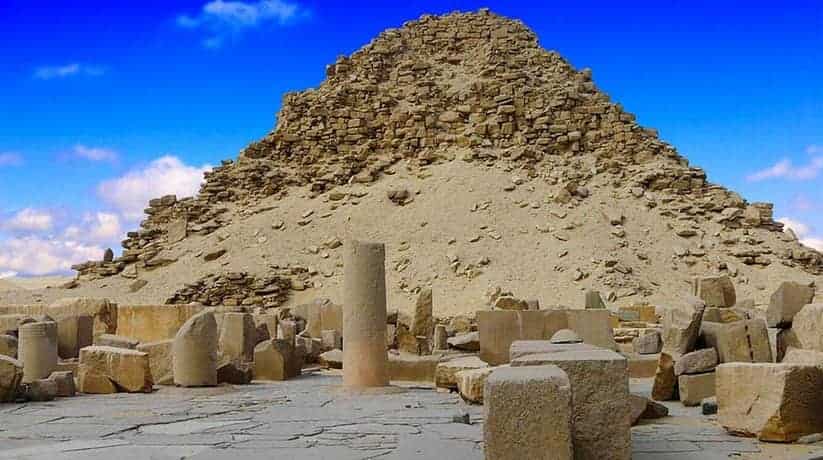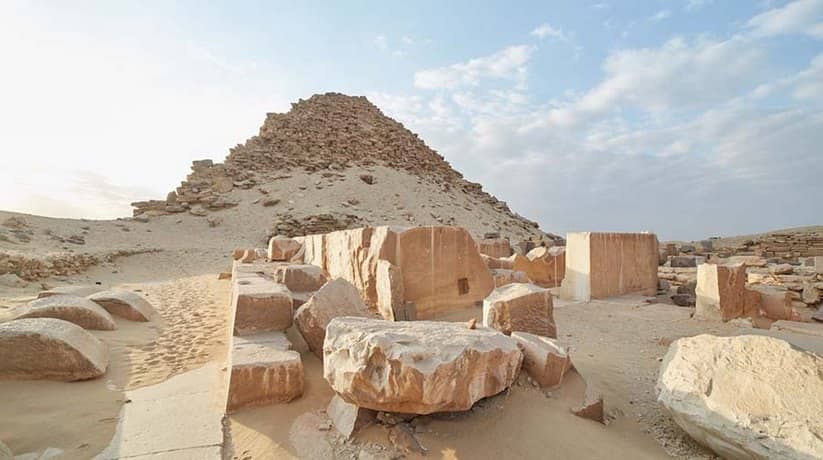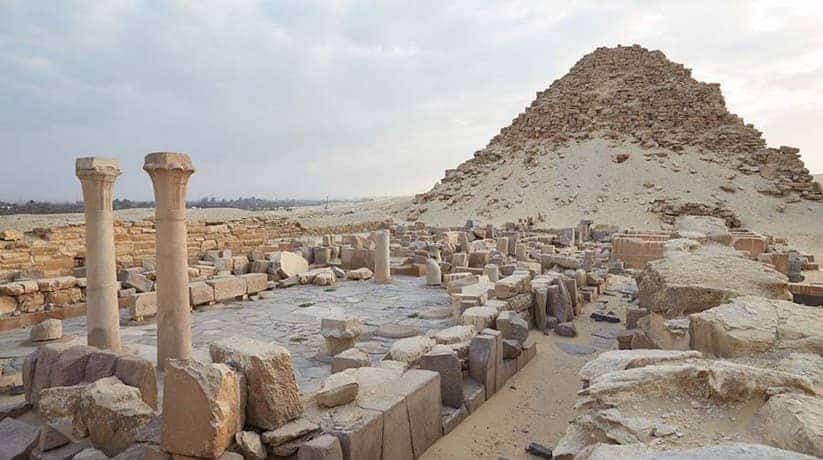Abusir Pyramids Cairo Egypt tours, booking, prices
Abusir Pyramids Cairo located on the western bank of the Nile, 25 kilometer southwest of Cairo, Egypt. In fact, Abusir Pyramids consisted of fourteen pyramids from the 5th Dynasty. Moreover, Abusir called the site of the forgotten kings of the 5th Dynasty. These kings do not have the fame of their predecessors from the 4th Dynasty. The pyramids site closed for many years to visitors. But, it is now open to the public. A northern extension made to the Sakkara necropolis. It was sometime during the Fifth Dynasty. The extension in the area called Abusir. By this time, tombs on the grandiose scale of the Fourth Dynasty were nonexistent. It was due to the decentralization of power from the pharaoh and the increase in the power of the nobility.
In fact, Abusir was not an oft used royal burial site. Though, the tomb of the Third Dynasty King Sekhemkhet unearthed there. It was in the 1950s. Userkaf was the first pharaoh of the Fifth Dynasty. He built his pyramid at Sakkara. In addition, four of his successors had also their tombs at Abusir. Yet Userkaf had built at Abusir before, not a tomb, but a temple. In fact, King Userkaf’s temple of the Sun is the earliest preserved Sun Temple in Egypt. Moreover, it is one of only two from the Old Kingdom that remain. The other built by Neuserre at Abu Ghurob. It is the northernmost monument at Abusir. Its location somewhat removed from the other structures. Furthermore, Userkaf ruled for only seven years. That is why he was unable to complete the construction.
Further details about Abusir Pyramids Cairo:
In fact, the design of the temple is simple. The lack of relief decoration is a sharp contrast to the lavish temples that came later. It indeed modeled after the Sun Temple at Heliopolis. Furthermore, the Sun Temple is a second temple at a lower elevation. The temple also called the Valley Temple. In fact, it is uncertain what function this temple had. It is because the Sun temple appears to be self-contained. Schott and Ricke have proposed that it connected with the worship of the goddess Neith. Goddess Neith cult became popular in the Memphis area during the Fifth Dynasty.
In fact, Abusir Pyramids Cairo are modest when compared to the mightiness of the Giza monuments. Indeed, they would be impressive if they completed. Moreover, the prime building material of the pyramids were the local limestone. Tura limestone used for casing stones and for relief work. Furthermore, the pathways and pavements made of black basalt. The columns and lintels made of red granite from Aswan. What the pyramids lacked in grandiosity they made up for in aesthetic appeal. Nearby are the mastabas, the flat tombs of priests, nobles and prominent citizens. Rather than being “huddled up” near the base of the Pyramids, these grouped into their own areas. It was possibly by class or occupation. In fact, Abusir used only occasionally to bury pharaohs. Mastabas were popular burial site among certain classes, especially the priesthood.
More details about Abusir Pyramids Cairo:
In fact, around fourteen Pyramids estimated to be at Abusir. But due to a degradation in construction methods, many have crumbled. It possibly to the point where they are now indistinguishable from the surrounding rubble. Many remain not found, but four of them excavated and studied . Moreover, of these four, only the Pyramids of Kings Sahure and Neferirkare are in stable condition. Niuserre pyramid has collapsed. Neferefre pyramid does not appear ever to have finished. Furthermore, Neferefre’s pyramid is not completely without merit. A Czech expedition working to excavate and restore Abusir. It found papyrus fragments in its mortuary temple.
In fact, Neferirkare’s pyramid was once much like the true Pyramids of Giza. The poor masonry and vandalism have left it looking more like the Step Pyramid of Zoser. In the Nineteenth century the famed Abusir papyri discovered nearby. They represented a monumental find. Papyri were everyday documents. They detailing finances, temples inventories, taxes, collections and expenditures. They also gave a focused look into the daily life and the work of the ancient Egyptians.
Here under more details about the four major Abusir Pyramids:
1-Sahura pyramid of Abusir Pyramids Cairo Egypt:
In fact, Sahura was the first to build himself a pyramid complex. It regarded as a milestone in the development of royal tombs. The dimensions of his pyramid are smaller than those of the forth dynasty pyramids. His mortuary and valley temples achieved greater importance. The funerary monument of Sahura from 2487-2475 BC. In fact, it is the most complete of the four royal burials at Abusir. It is the quintessential fifth Dynasty pyramid complex. Furthermore, it consists of valley temple, causeway, mortuary temple and pyramid. The imposing portico of the mortuary temple gave access to a large courtyard. It is with a well preserved basalt paved floor and a colonnade. The colonnade consists of sixteen red granite palm columns. They now destroyed.
The remains of the original limestone walls are fine painted decoration. They have transferred to the Egyptian Museum in Cairo and the Bode museum in Berlin. The mortuary Temple designed with finely worked building materials. The red granite used for the palm columns. walls decorated with superb poly-chrome scenes in low relief. They showed mythical scenes of the ruler victories. The victories are in battle against Egypt’s traditional enemies. They also show hunting scenes and ships. Beyond the colonnade were a series of store rooms surrounding the ‘statue chamber’. They are where the king statues stood in niches. Next to the pyramid was the sanctuary with its alabaster altar. Sahure’s valley temple on the edge of the desert served as a landing place. It linked to the Nile by a canal. A causeway led from this temple to the mortuary temple.
2-Neferirkara Pyramid of Abusir Pyramids Cairo:
Neferirkara ruled from 2492-2482 BC. Neferirkara Pyramid located on the most elevated site in the cemetery. The pyramid changed in the course of construction from a stepped into a true pyramid. Its height is 74 meters. The pyramid left unfinished as a result of the rulers premature death . His mortuary temple constructed of mud bricks and wood. It was by his sons and heirs, Neferirkara and Newoserra .
At the end of the nineteenth century tomb robbers discovered a papyrus archive. It called the first Abusir Archive in the storage rooms of the• mortuary temple. The papyri date back to the reign of Issesi to that of Pepi II. It consists of rotas for temple personnel, inventories of cult objects and letters. These record date back to the last part of the fifth dynasty to the end of the sixth. Neferirkara’s causeway usurped by Nyuscrra. Nyuscrra diverted it to his own mortuary temple. On the southern side of Neferirkara pyramid is smaller pyramid complex. It belongs to his wife, Khentkawes II . Valuable finds from the queen’s mortuary temple have included many papyrus fragments.
3- Neferefre Pyramid of Abusir Pyramids Egypt:
Neferirkare is the eldest son of Neferefre. He ruled for only two years. His unfinished pyramid changed into a mastaba. An architectural unique mortuary temple built of mud bricks. A cult abattoir, known as “the Sanctuary of the Knife.”. It connected with that mortuary temple. Fragments of pyramid foundations have uncovered between Sahure’s pyramid and Userkar’s sun temple. They attributed to Neferefre’s ephemeral successor.
4- Nyuserre Ini’s Pyramid of Abusir Pyramids Cairo Egypt:
Newoserra built his pyramid at the northeastern corner of Neferirkare Pyramid. The open courtyard of Nyuserre Ini mortuary temple adorned with Papyrus-form. Th columns made of red granite with relief decoration. Repulnub, does not appear to buried in the vicinity of her husband’s tomb. Her tomb may be one of the pyramid complexes that constructed in that time. Excavations in pyramid 24 have provided valuable information about its mode or construction. The name of its owner remains unknown. Nyuserre Ini’s successor, Mekauhor, abandoned the Abusir necropolis. Other members of the royal family of that time also buried in the vicinity of the pyramids.
The largest of their tombs belonged to the vizier Ptahshepses. Nyuserre Ini’s son-in-Iaw; that twice extended mastaba almost rivaled the royal complexes in size. During the First Intermediate Period. There were no royal mortuary cults at Abusir. Although brieny revived at the beginning of the Middle Kingdom. From this period to the late period, Abusir became a cemetery for the common people. A cemetery in southwestern Abusir built to contain huge shaft tombs. They date back to the end of the twenty sixth dynasty. Among them was the tomb of Udjahorresnet. Chancellor of Egypt Persian kings. His tomb constructed with a cunning system of linked shafts and filled with sand. This supposed to prevent access to the burial chamber.

















